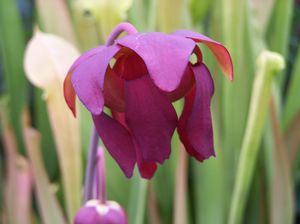View All Plants :: View All POND & WETLAND PLANTS :: View All SUN PERENNIALS
Sarracenia x 'Dixie Lace'
Hybrid Pitcher Plant
Plant Type:
POND & WETLAND PLANTSSarracenia x ‘Dixie Lace’ – is a lovely complex hybrid made at the University of North Carolina at Charlotte (UNCC). Red flowers occur freely beginning mid-season above consistently red-purple foliage with some white spotting and red veining. S. psittacina influence can be seen in the hood as the front is tightly closed and squared-off at the pitcher hole when the pitchers emerge. Gradually the hoods flatten down into a convex form, flaring beyond the entrance hole which is now opened for business. The tube near the top broadens to as much as 1.5” wide. The pitchers tend to be vertical with a gentle lean away from the plant’s center. It’s a quick grower with apparent hybrid vigor. Very nice. Please see the Genus Overview below.
Characteristics and Attributes for Sarracenia x 'Dixie Lace'
Season of Interest (Flowering)
- Spring
Season of Interest (Foliage)
- Four Seasons
Nature Attraction
- Insectivore
Light
- Morning Sun / Afternoon Shade
- Full Sun
Attributes
- Potted Plant
- Bog
- Marginal
Growth Rate in the Garden
- Moderately Fast
Soil
- Sandy
- Wet
- Acid
Origins
- Garden Origin
Propagated By
- Division
Genus Overview: Sarracenia
Common Name: Pitcher Plant
These are the fascinating Pitcher Plants. All are from eastern North America, most from Southeastern U.S. One species occurs in the north all the way up into Newfoundland in peat bogs, Sarracenia purpurea with USDA zone 4 hardiness... perhaps some populations hardy into zone 3. The spring and summer flowers which last for many weeks are as beautiful as they are fascinating. All species have evolved pitchers with passive pitfall traps… the insects enter but can’t back up due to downward facing hairs which disallow retreat. They are structurally curious and in their own unique way very beautiful. All require constantly moist to wet feet, boggy conditions suit them well or can be easily pot grown in 50% coarse sand to 50% peat mix. In a natural setting they can tolerate vernal flooding but for most of the year their crowns must be above the water line or they will rot… yes, I know: it’s hard to believe! Most of the literature tells you not to feed them and it is true that any chemical fertilizer should be avoided as these plants have little tolerance to salts. But you can use quarter strength fish emulsion on occasion and I mean only on occasion, not at every watering, and only during active growth. Potted plants must be re-potted every 2 years with a fresh mix of peat and coarse sand or they languish. They are easy to transplant and respond well to good treatment. Most prefer sun although I have found that S. purpurea seems particularly happy during the summer under the shade cloth in my greenhouse. That was a bit of a surprise as I’ve seen them growing in the bright open sunny conditions in the fantastic peat bogs of Nova Scotia. Generally I would say they need be planted in full sun in the north to to partly shaded exposure in the south. They make fascinating potted plants. All of the following are offered by division.


